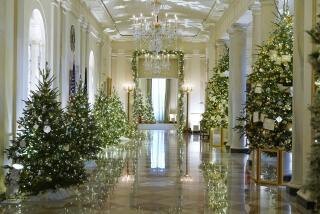DECORATING : Victoriana Enters the White House . . . and a New Era of Respectability
- Share via
Victorian decorating, in the doghouse for most of the 20th Century, has moved into the White House. The Treaty Room and the Lincoln sitting room have been done in high Victorian style for President and Mrs. Clinton.
Nina Hughes, a New York decorator, says that while the Clintons are giving the style visibility, Victorian decorating has been gaining acceptance for several years.
“The further away from the period we have gotten, the more respectable it has become,” says Hughes, a consultant on furnishings when the late 19th-Century New Jersey State House in Trenton was restored.
A totally Victorian interior, as in the White House rooms, is rare today. Most people settle for a few pieces as, in Hughes’ words, “a decorative element to create tension and interest in their rooms.”
The problem with Victorian, Hughes says, is that “more styles were introduced in the Victorian era than perhaps at any other time. Virtually every period had its renaissance during that era.”
Unlike today, those eclectic Victorian rooms filled with different elements competing for attention weren’t considered a mishmash.
“Having a room furnished with a Moroccan pouf, a lacquer table from the Orient, a wicker piece and seating, each covered with a different fabric, showed that you were cultivated and knew about these things,” Hughes says. “We are doing the same kind of thing but with greater control and less abandon.”
The ultimate Victorian living room probably wouldn’t suit today. For example, the lamp-lit center table--often the focal point of the parlor--would most likely obstruct the sight line to the TV set.
In a modern living room, the main part of the room is the seating, with a low coffee table that doesn’t block the tube. With or without television, the appeal of Victorian style is the nostalgia it evokes.
“It seems as if it was a more secure and reassuring time when life was easier for the middle class,” Carol McD. Wallace says.
Wallace is author of “Victorian Treasures: An Album and Historical Guide for Collectors” (Abrams, 1993, $34.95). The book offers a tour through the Victorian home, explaining the furnishings of each room.
Many of the pieces are in antiques shops and flea markets, just waiting for good homes.
“There was so much of this stuff made, and many people still have it,” Wallace says. “So long as you are willing to look beyond the tarnish of silver-plate and the dust of old china and glass, you can find what you need at country and suburban flea markets. And shops, auctions and tag sales are sources for furniture and accessories. I saw a Victorian armchair not long ago, out in front of a store in the country for $99--and it was perfectly fine.”
The effect of Victoriana on a room varies with the furnishings. For a subtle reference to the era, include at least one deep rich hue such as maroon, green or brown in a color scheme, Wallace suggests. For a stronger flavor, select a 19th-Century “parlor suite” of a love seat and two armchairs. These pieces--upholstered perhaps in a paisley--are among the most telling ways to create the atmosphere in the living room.
A hall stand with mirror sets a Victorian tone in the foyer. These relics of the late 19th and early 20th centuries usually have hooks for hats and coats, a shelf for mail and sometimes even a seat for donning or removing boots.
In the dining room, a chandelier over the table adds a formal, late 19th-Century touch to almost any furniture. For bedrooms, a washstand with marble top and pivoting mirror is practical and small enough to fit a small or medium-sized room.
One of the most characteristic aspects of Victorian decorating is a lot of fabric at the windows. Wallace suggests adding a layer of fabric to existing window treatments--a swag, a pair of drapery panels or sheer under-curtains.
“We went a bit wild with the swags, tails and tassels for the curtains,” says Priscilla Townes. She and her husband restored an 1870s brick house in Brooklyn.
Townes says they had trouble finding building materials and artisans but no trouble finding period and reproduction furniture and accessories.
“There is a fantastic amount of material available,” says decorator Hughes, “so much so that it’s daunting for the neophyte.”


